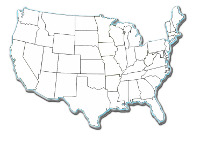Weather-related news from the U.S. has recently been generating more column space than usual, thanks to events of an unprecedented kind. When Hurricane Sandy made landfall upon the northeastern states, much of the world was treated to the bizarre spectacle of seeing New York City’s subway rail system and major thoroughfares flooded, with hundreds of thousands of metropolitan residents left without power.
Events such as these would justifiably make any prospective U.S. expat resident wonder if there are any completely safe areas in the country, where inclement weather is concerned. The 21st century is indeed shaping up to be an odd one for meteorological phenomena – and whether or not this owes itself to man made global warming is a fiery debate for another day – yet there are still areas of the country that are relatively free from nature’s fiercest lashings.Though the National Weather Service is compelled to bring us the bad news, i.e. that “virtually no location in the U.S. is 100% safe from dangerous weather” and that “the combination of flooding, lightning, tornadoes, tropical cyclones, snow/ice storms, extreme heat, extreme cold, high winds, and rip currents claims almost 600 lives each year in the U.S., on average” there are still huge portions of the country that can exist unmolested by killer weather.
Cold and Warm Climes = Safer?
Some of the safest areas of the country in terms of disaster avoidance are, interestingly, ones that are well outside of the ‘mild’ climate range. Upstate New York and other regions close to the Canadian border, though they see their share of snowfall and even blizzards, rarely generate fatalities or the types of massive power outages heavily reported during the ‘Sandy’ crisis. Needless to say, in a part of the country referred to as the ‘snow belt’ (Western and upstate New York, as well as the Great Lakes region – particularly the Upper Peninsula of Michigan), there is plenty of the white flaky stuff to go around, yet the strong preparedness of the citizenry for all but the worst blizzards (think 2 feet of snow or more) makes living through it simpler than it might first seem.
Your reward for this generally comes in the form of exceptionally mild, pleasant summers. The same generally holds true, if we switch out ‘pleasant summer’ with ‘pleasant winter,’ for arid climes like Arizona and New Mexico: despite the shortage of rainfall here (a typical year in Arizona would be called a drought year for the perpetually wet Pacific Northwest states).
Exceptions to the Rules
The Carolinas along the Eastern seaboard, along with the eastern portion of Florida, always remain on alert for intense hurricane winds and lashing rains, yet there are some observations about this area that might seem counter-intuitive: namely, that the North Carolina city of Asheville is considered one of the ten safest cities in the U.S. for weather. The horse racing city of Lexington, Kentucky, is another oasis in a state that might otherwise be associated with the worst of seasonal storms.
'Tornado alley'
The infamous ‘Tornado Alley’ in the center of the U.S., comprising Kansas, Oklahoma, and parts of Missouri and Texas, also has some hidden charms for those who like unpredictability and / or variety in climate – given the frequency with which cold air masses and warm air masses alternate over the region, rapid changes in temperature during the spring and winter can quickly break any weather-related monotony. Tornadic activity in the region has decreased overall in the last few years, with 2012 being a “below average” year for such according to NOAA, though the tornado outbreaks that do occur can be quite violent. At least one tornado in this region over the past two years – an EF5 tornado that leveled Joplin, Missouri on May 22 of 2011 – was significant enough to be declared a federal ‘state of emergency,’ urging president Obama to drop other items from his itinerary and make a special visit to the region.
However, perhaps a more serious threat in the Plains States now is that of drought, which has been a running theme over the years since the Joplin tornado. Though it is difficult to say what the next few years will bring, summers in the region from south Kansas to north Texas can be catastrophically free of rain. Yet another state of emergency, directly related to this issue, was declared for the drought-stricken southern Illinois responsible for much of the nation’s food crops: in 2012 the region was designated as suffering from “extreme” drought, which is the second worst drought category next to “exceptional”.
California Dreamin'
We can hardly finish this quick survey without mention of Southern California, which many foreign observers see as the epicenter of American weather disasters. Those who are biding their time waiting for the apocalyptic earthquake that will merge Los Angeles and San Francisco into a single city don’t have to wait for that to witness the wrath of nature (hint: wildfires). Even here, though, ‘lesser’ cities such as San Diego have a good degree of immunity from these scenarios, with only the feeblest of tornadoes touching down in the area and thunderstorms being similarly rare.


